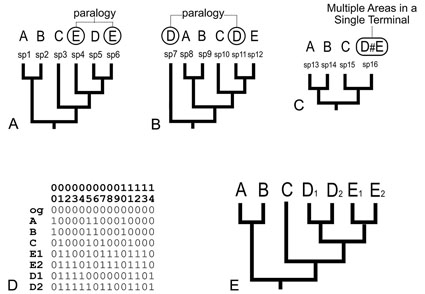Abstract
Brooks Parsimony Analysis is a cladistic biogeographic method that aims to extract biogeographic information from phylogenetic trees, depicting from a group of cladograms a general pattern of relationships among the areas the taxa inhabit. We present here BuM 2.0, an online framework to automatically create matrices for Brooks Parsimony Analysis (BPA) using Baum & Ragan’s algorithm for Matrix Representation with Parsimony.
References
Amorim, D.S., Santos, C.M.D. & Oliveira, S.S. (2009) Allochronic taxa as an alternative model to explain circumantarctic disjunctions. Systematic Entomology, 34, 2–9. https://doi.org/10.1111/j.1365-3113.2008.00448.x
Baum, B.R. (1992) Combining trees as a way of combining data sets for phylogenetic inference, and the desirability of combining gene trees. Taxon, 41, 3–10. https://doi.org/10.2307/1222480
Baum, B.R. & Ragan, M.A. (2004) The MRP method. In: Bininda-Emonds, O.R.P. (Ed.), Phylogenetic supertrees Springer, Dordrecht, pp. 17–34. https://doi.org/10.1007/978-1-4020-2330-9_2
Brooks, D.R., Dowling, A.P.G., van Veller, M.G.P. & Hoberg, E.P. (2004) Ending a decade of deception: a valiant failure, a not-so-valiant failure and a success story. Cladistics, 20, 32–46. https://doi.org/10.1111/j.1096-0031.2003.00011.x
Brooks, D.R., van Veller, M.G.P. & McLennan, D.A. (2001) How to do BPA, really. Journal of Biogeography, 28, 345–358. https://doi.org/10.1046/j.1365-2699.2001.00545.x
Caballero-Viñas, C., Sánchez-Nava, P., Aguilar-Ortigoza, C. & Morrone, J.J. (2021) Dispersal of North American Polymorphidae (Acanthocephala) and aquatic birds (Anatidae and Rallidae) along the Central Migratory Flyway. Journal of Zoological Systematics and Evolutionary Research, 59, 561–575. https://doi.org/10.1111/jzs.12450
Capellari, R.S. & Santos, C.M.D. (2012) Realism in systematics through biogeographical consilience. Cladistics, 28, 170–173. https://doi.org/10.1111/j.1096-0031.2011.00363.x
Croizat, L. (1964) Space, time, form: The biological synthesis. Published by the author, Caracas.
Ebach, M.C., Morrone, J.J., Sanmartín, I. & Escalante, T. (2017) Progress in historical biogeography. Australian Systematic Botany, 29, ii. https://doi.org/10.1071/SBv29n6_FO
Ebach, M.C., Morrone, J.J., Sanmartín, I. & Escalante, T. (2018) Further progress in historical biogeography. Australian Systematic Botany, 30, i. https://doi.org/10.1071/SBv30n6_ED
Frota, A., Morrone, J.J. & da Graça, W.J. (2020) Evolutionary biogeography of the freshwater fish family Anablepidae (Teleostei: Cyprinodontiformes), a marine-derived Neotropical lineage. Orgamisms Diversity and Evolution, 20, 439–449. https://doi.org/10.1007/s13127-020-00444-1
Goloboff, P.A. & Catalano, S.A. (2016) TNT version 1.5, including a full implementation of phylogenetic morphometrics. Cladistics, 32, 221–238. https://doi.org/10.1111/cla.12160
Hammoud, M., Gois, J.P., Santos, D., Sampronha, S. & Santos, C.M.D. (2019) Building combined MRP-matrices with BuM, an automated web-tool. Zootaxa, 4567 (2), 387–394. https://doi.org/10.11646/zootaxa.4567.2.11
Maddison, W.P. & Maddison, D.R. (2019) Mesquite: A modular system for evolutionary analysis. Version 3.61. Available from: http://www.mesquiteproject.org (accessed 9 June 2021)
Morrone, J.J. (2020) The Mexican Transition Zone: A natural biogeographic laboratory to study biotic assembly. Springer, Cham, XII + 191 pp. https://doi.org/10.1007/978-3-030-47917-6
Morrone, J.J. (2021) Croizat’s dangerous ideas: Practices, prejudices, and politics in contemporary biogeography. History and Philosophy of the Life Sciences, 43, 1–45. https://doi.org/10.1007/s40656-021-00436-0
Morrone, J.J. & Crisci, J.V. (1995) Historical biogeography: Introduction to methods. Annual Review of Ecology and Systematics, 26, 373–401. https://doi.org/10.1146/annurev.es.26.110195.002105
Nelson, G. & Ladiges, P.Y. (1996) Paralogy in cladistic biogeography and analysis of paralogy-free subtrees. American Museum Novitates, 3167, 1–58.
Parenti, L.R. & Ebach, M.C. (2009) Comparative biogeography: Discovering and classifying biogeographical patterns of a dynamic Earth. University of California Press, Berkeley. https://doi.org/10.1525/california/9780520259454.001.0001
Pisani, D. & Wilkinson, M. (2002) Matrix representations with parsimony, taxonomic congruence, and total evidence. Systematic Biology, 51, 151–155. https://doi.org/10.1080/106351502753475925
Ragan, M.A. (1992) Phylogenetic inference based on matrix representation of trees. Molecular Phylogenetics and Evolution, 1, 53–58. https://doi.org/10.1016/1055-7903(92)90035-F
Santos, C.M.D. (2011) On the role of assumptions in cladistic biogeographical analyses. Papéis Avulsos de Zoologia, 51, 295–305. https://doi.org/10.1590/S0031-10492011001900001
Santos, C.M.D. & Capellari, R.S. (2009) On reciprocal illumination and consilience in biogeography. Evolutionary Biology, 36, 407–415. https://doi.org/10.1007/s11692-009-9070-y
Zandee, M. & Roos, M.C. (1987) Component-compatibility in historical biogeography. Cladistics, 3, 305–332. https://doi.org/10.1111/j.1096-0031.1987.tb00896.x


